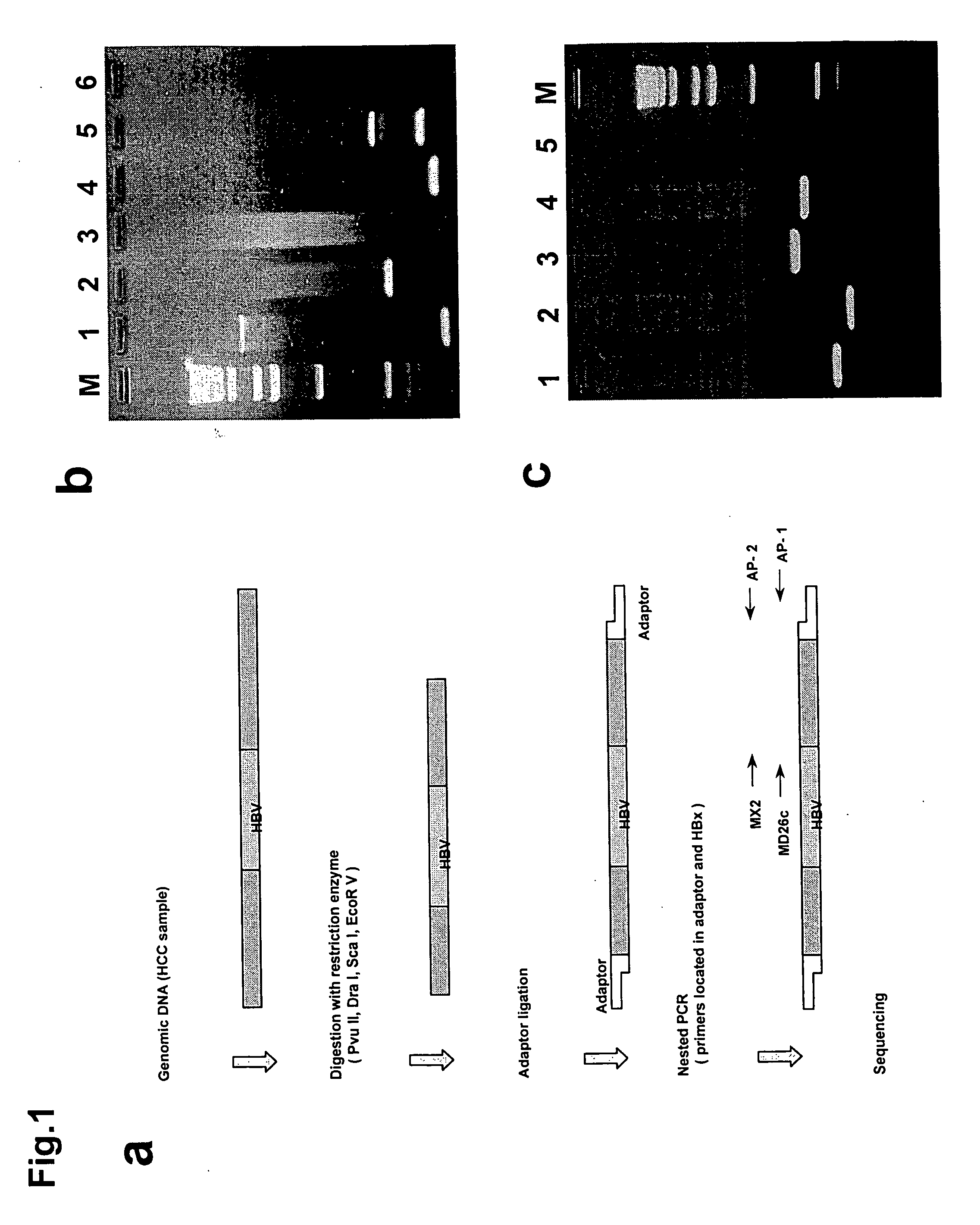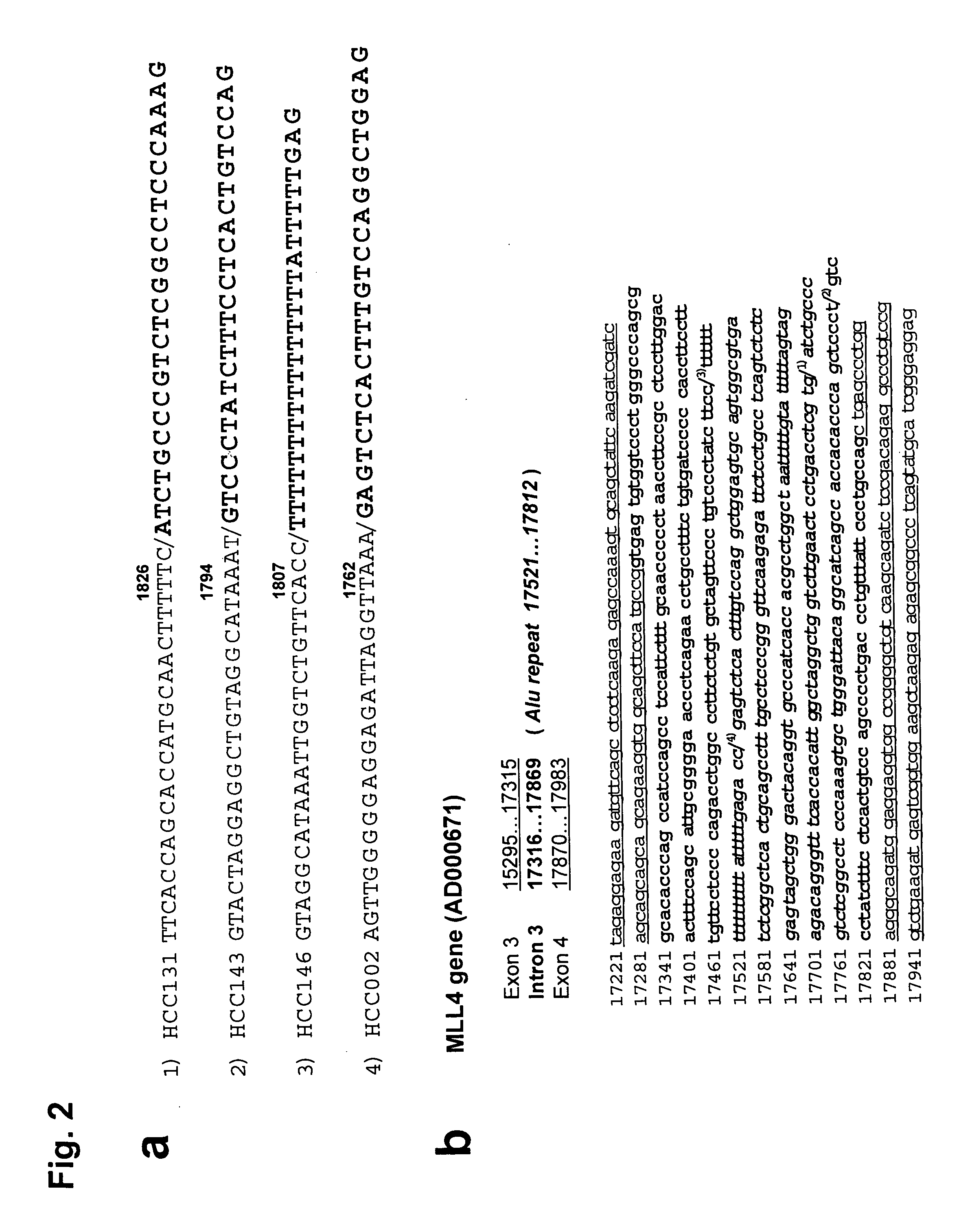Method of Detecting Carcinogenesis Caused by Hepatitis B Virus
- Summary
- Abstract
- Description
- Claims
- Application Information
AI Technical Summary
Benefits of technology
Problems solved by technology
Method used
Image
Examples
example 1
(a) Histological and Serological Examinations of the Hepatocyte Samples
[0153]The following tests were carried out using resected liver tumor tissue (hepatocellular carcinoma or HCC) from 26 Japanese patients obtained at the Second Department of Surgery, Chiba University Hospital, between 1987 and 2003. These patients had not undergone preoperative treatment.
[0154]Clinical, histological, and serological examinations were carried out on the patients providing the samples. In the histological examination, the tumor size, degree of differentiation of the tumor cells (three stages), and type of liver disease (CPH: chronic persistent hepatitis; CAH: chronic acute hepatitis; LC: liver cirrhosis) were investigated. In the serological examination, hepatitis B surface antigen (HBsAg) detection was carried out using an enzyme immunoassay (EIA) kit from Dinabot Co., Ltd., and antibody against the hepatitis B surface antigen (anti-HBs antibody) and antibody against the hepatitis B core antigen (...
example 2
Detection of HBx / MLL4 Fusion Transcription Products by RT-PCR
[0181]The coding region for HBx protein excluding the C-terminal and the promoter region of HBx (X gene of HBV-DNA) were present in all 4 cases in which MLL4 / HBV-DNA integration had been confirmed. The presence of HBx / MLL4 fusion transcription products in these 4 samples was predicted on this basis. The total RNA was extracted from HCC131, HCC143, HCC146, and HCC002 and the transcription products obtained by RT-PCR were investigated.
[0182]The details of the test procedure are given below.
[0183]The RNA was extracted using Trizol (Invitrogen) according to the instructions for use. The extracted RNA was confirmed by electrophoresis on 1.2% agarose gel. RT-PCR was carried out as follows using a Superscript One-Step RT-PCR system (Invitrogen) according to the instructions for use; gene-specific primers designed on exon 5 or 6 of MLL4 (E5-1: SEQ ID NO. 15; E5-2: SEQ ID NO. 16; and E6-1: SEQ ID NO. 17) were used as the reverse tr...
example 3
Detection of HBx / MLL4 Fusion Proteins by Immunoblotting Analysis
[0188]In order to confirm the actual translation of these fusion transcription products into protein, a comparison was carried out by immunological test procedures using liver tumor cells and cells adjacent thereto for HCC131, HCC143, and HCC002.
[0189]The details of the test procedures are as follows. The complete protein was prepared by lysing 100 to 200 mg of cells with a buffer that contained 0.1% SDS, 0.5% deoxycholate, 1% NP-40, 150 mM NaCl, 50 mM Tris-HCl (pH 8.0), 1 mM APMSF, and other protease inhibitors (complete protease inhibitor tablets, Roche) followed by centrifugation at 12,500 rpm for 30 minutes at 4° C. Optionally, 500 μg of the obtained total protein was incubated with anti-HBx (hepatitis B virus X protein) monoclonal antibody (Advanced Immuno Chemical, Inc.), and immunoprecipitation was performed by a standard method.
[0190]The total protein and the immunoprecipitated product prepared by the preceding ...
PUM
| Property | Measurement | Unit |
|---|---|---|
| Volume | aaaaa | aaaaa |
| Size | aaaaa | aaaaa |
| Size | aaaaa | aaaaa |
Abstract
Description
Claims
Application Information
 Login to View More
Login to View More - R&D
- Intellectual Property
- Life Sciences
- Materials
- Tech Scout
- Unparalleled Data Quality
- Higher Quality Content
- 60% Fewer Hallucinations
Browse by: Latest US Patents, China's latest patents, Technical Efficacy Thesaurus, Application Domain, Technology Topic, Popular Technical Reports.
© 2025 PatSnap. All rights reserved.Legal|Privacy policy|Modern Slavery Act Transparency Statement|Sitemap|About US| Contact US: help@patsnap.com



